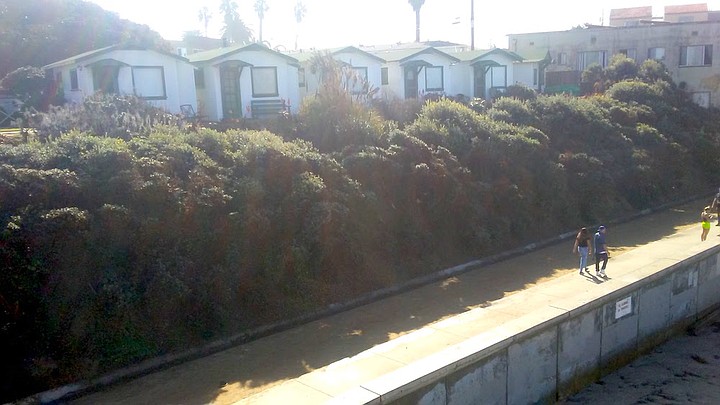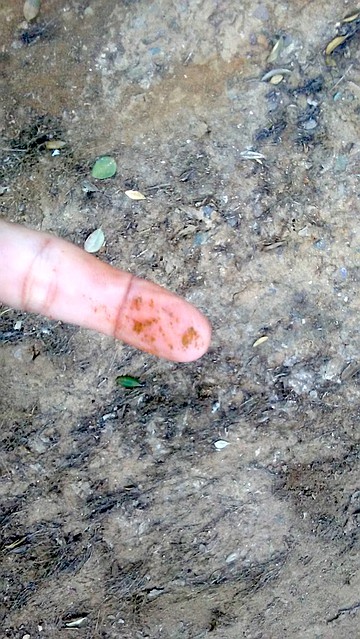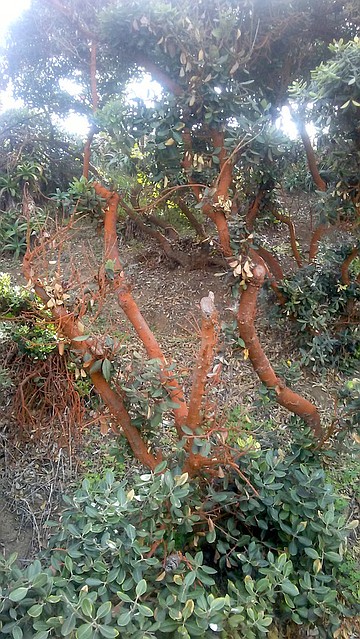 Facebook
Facebook
 X
X
 Instagram
Instagram
 TikTok
TikTok
 Youtube
Youtube

Next time you are strolling along the pier in Ocean Beach enjoying the views of the sunset and surfers, turn your back to the ocean to see something else pretty awesome — orange-colored trees — not orange trees, but orange-colored trees with green foliage.

Located south of the pier, running along the length of the seawall, the trees are lined up along the bluff below some cottages. “The guy who planted them said they turn orange every year ’bout this time,” Henry — whose parents own the property — told me. “I can’t remember the name of the tree. We’ve lost a few over the years, but they always grow back; you can see some new foliage starting on some of the ones we lost,” he said while trimming hedges and cleaning up the sidewalk.
The trees, Metrosideros collina, or springfire trees, produce large red blooms from mid-spring through mid-summer and thrive in coastal areas.

“They do produce big flowers in the summer,” Henry continued, “but I’m not sure why the trunks and branches are orange. I planted these specifically because they are supposed to do well at the coast.”
The coating on the tree limbs and trunks feels like a rusty film that can be rubbed off, but not entirely: the branches and trunks remain tinted, and a semi-sticky silty layer is left behind. The orange substance does not seem to have any effect on the foliage.
I started to wonder — do trees rust?
“It’s likely algae from the salt air as it blows in,” explained Butch Everett from Tree Life Consulting. “See here…the trees in the back aren’t as bad — it’s still there, but not as bad as the ones in the front,” he said while inspecting the area. “You can feel its kinda wet…. It’s an algae from the salt and from the plant. It probably has a little bit of fungal pathogen in it as well, so it probably has a little bit of rust, but I think it’s mostly algae….

"It’s definitely affecting the oxygen exchange because there’s lenticels — like little breathing ports — so you’re not getting a lot of different types of mineral exchanging because it’s all got this algae-like cover on [the lenticels] from the salt spray.”
Everett climbed further up the bluff to explain new growth along the bottom of the trees.
“That’s what we call epicormic shoots: basically, the plant doesn’t have enough energy to send the leaves all the way to the top, and that’s why you’re seeing the tops on these die out. Normally you’d see it in older plants and trees, but this is all just salt influence…see this haze?
"I haven’t seen this before, and we don’t have an exact answer for everything, but that’s what that is, algae…. You could have some rust forming on the algae, but if you take your fingers and feel it, it’s not slimy but you can feel the moisture and the dampness in it.”


Next time you are strolling along the pier in Ocean Beach enjoying the views of the sunset and surfers, turn your back to the ocean to see something else pretty awesome — orange-colored trees — not orange trees, but orange-colored trees with green foliage.

Located south of the pier, running along the length of the seawall, the trees are lined up along the bluff below some cottages. “The guy who planted them said they turn orange every year ’bout this time,” Henry — whose parents own the property — told me. “I can’t remember the name of the tree. We’ve lost a few over the years, but they always grow back; you can see some new foliage starting on some of the ones we lost,” he said while trimming hedges and cleaning up the sidewalk.
The trees, Metrosideros collina, or springfire trees, produce large red blooms from mid-spring through mid-summer and thrive in coastal areas.

“They do produce big flowers in the summer,” Henry continued, “but I’m not sure why the trunks and branches are orange. I planted these specifically because they are supposed to do well at the coast.”
The coating on the tree limbs and trunks feels like a rusty film that can be rubbed off, but not entirely: the branches and trunks remain tinted, and a semi-sticky silty layer is left behind. The orange substance does not seem to have any effect on the foliage.
I started to wonder — do trees rust?
“It’s likely algae from the salt air as it blows in,” explained Butch Everett from Tree Life Consulting. “See here…the trees in the back aren’t as bad — it’s still there, but not as bad as the ones in the front,” he said while inspecting the area. “You can feel its kinda wet…. It’s an algae from the salt and from the plant. It probably has a little bit of fungal pathogen in it as well, so it probably has a little bit of rust, but I think it’s mostly algae….

"It’s definitely affecting the oxygen exchange because there’s lenticels — like little breathing ports — so you’re not getting a lot of different types of mineral exchanging because it’s all got this algae-like cover on [the lenticels] from the salt spray.”
Everett climbed further up the bluff to explain new growth along the bottom of the trees.
“That’s what we call epicormic shoots: basically, the plant doesn’t have enough energy to send the leaves all the way to the top, and that’s why you’re seeing the tops on these die out. Normally you’d see it in older plants and trees, but this is all just salt influence…see this haze?
"I haven’t seen this before, and we don’t have an exact answer for everything, but that’s what that is, algae…. You could have some rust forming on the algae, but if you take your fingers and feel it, it’s not slimy but you can feel the moisture and the dampness in it.”
Comments